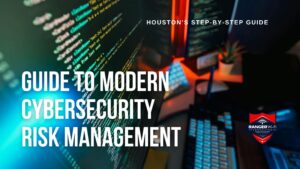
Houston businesses are facing a sharper rise in cybersecurity threats, and most of it comes from gaps in basic risk management. As companies rely more on cloud apps, remote teams, and third-party vendors, understanding what you’re actually protecting becomes the first line of defense. A strong Houston cybersecurity foundation isn’t only about firewalls or software. It starts with knowing your environment, pinpointing where vulnerabilities live, and building a plan you can update as threats evolve. The steps below outline how to build a practical, repeatable framework that keeps your organization resilient.
Step 1: Identify Your Key Information Assets
To begin, the risk management team should make a habit of comprehensively cataloging all information assets within the organization. This includes the IT infrastructure, as well as various Software-as-a-Service (SaaS) and Platform-as-a-Service (PaaS) solutions used.
Additionally, it is crucial to consider the data processed by these systems. The cataloging should also cover the information assets utilized by third-party vendors since they pose a significant data breach risk.
Step 2: Evaluate the Risks That Threaten Those Assets
Once the information assets are successfully identified, the next step is to go through the associated risks to the organization. You must segregate and organize so that not all assets have the same level of importance, and certain vendors may present higher security risks than others.
Step 3: Analyze Risk by Likelihood and Impact
This step of the entire process includes analysis of the identified risks and assigning priority tasks based on two key factors: probability and impact. Ask these questions:
- Evaluate the risk of cybercriminals gaining access to each asset (this covers the probability part).
- Assess the financial, operational, strategic, and reputational impact of a security event (impact).
- Calculate the risk tolerance level by multiplying the probability by the impact.
- Devise the appropriate response.
Step 4: Put the Right Security Controls in Place
This step involves defining and implementing security controls to effectively manage potential risks that are liable to the country.
These controls help eliminate or significantly minimize the likelihood of security incidents. It is essential to involve the entire organization in implementing and ensuring continuous adherence to these controls.
Examples of security controls include:
- Implementing network segregation to compartmentalize sensitive data.
- Employ encryption for data at rest and in transit.
- Utilizing reliable anti-malware, anti-ransomware, and anti-phishing software.
- Configuring firewalls to protect against unauthorized access.
- Establishing password protocols and implementing multi-factor authentication.
- Conduct regular workforce training to enhance cybersecurity awareness.
- Implementing a robust vendor risk management program.
Step 5: Continuously Monitor and Adjust Your Cybersecurity Plan
In this day and age’s rapid evolution, relying solely on periodic audits and penetration testing is not the right way to move forward.
Continuous monitoring and review are needed to stay ahead of the game. Organizations need to maintain a flexible risk management program that proactively monitors the IT environment for new risks. Regularly evaluate and adapt response mechanisms to maintain a robust cybersecurity profile.
Closing Note
Reach out to RangerWi-Fi Consulting to help you guard your network. For more information, contact us at (281) 638 8835 or schedule an appointment online.

